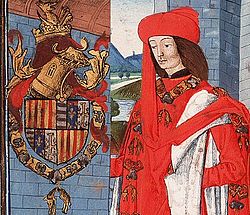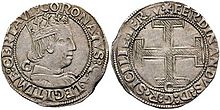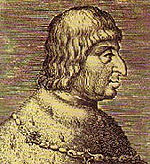- Ferdinand I of Naples
-
- Ferdinand I of Naples should not be confused with Ferdinand I of the Two Sicilies, a latter king of Naples.
Ferdinand I 
King of Naples Reign 1458 - 1494 Predecessor Alfonso I Successor Alfonso II Spouse Isabella of Taranto
Joanna of AragonIssue Alphonso II of Naples
Eleanor of Naples
Frederick IV of Naples
John of Naples
Beatrice of Naples
Francis of Naples, Duke of Sant Angelo
Joan of Naples
Charles of Naples
Ferdinando d'Aragona y Guardato, 1st Duke of Montalto
Maria d'Aragona
Giovanna d' Aragona
Maria d'Aragona
Ferdinand d'Aragona, Count of Arsena
Arrigo d'Aragona, Marquess of Gerace
Cesare d'Aragona, Marquess of Santa Agata
Leonor d'Aragona
Lucrezia d'AragonaHouse House of Trastámara Father Alfonso V of Aragon Mother Giraldona Carlino Born June 2, 1423 Died January 25, 1494 Ferdinand I (June 2, 1423 – January 25, 1494), also called Don Ferrante, was the King of Naples from 1458 to 1494. He was the natural son of Alfonso V of Aragon by Giraldona Carlino.
Contents
Biography
In order to arrange a good future for Ferdinand, King Alfonso had him married in 1444 to a feudal heiress, Isabella of Taranto, who besides being the elder daughter of Tristan di Chiaramonte (Tristan de Clermont-Lodeve), Count of Copertino, and Catherine of Baux Orsini, was the niece and heiress presumptive of childless prince Giovanni Antonio del Balzo Orsini of Taranto. She was a granddaughter of Queen Mary of Enghien (mother of Giovanni and Catherine), who had been Queen consort of Naples (Queen of Jerusalem and Sicily) in 1406-14.
Ferdinand's wife was the heiress presumptive of remarkable feudal possessions in Southern Italy.
He used the title King of Naples and Jerusalem (Ferdinand I of Naples). In accordance with his father's will, Ferdinand succeeded Alfonso on the throne of Naples in 1458, when he was 35 years old, but Pope Calixtus III declared the line of Aragon extinct and the kingdom a fief of the church. But although he died before he could make good his claim (August 1458), and the new Pope Pius II recognized Ferdinand's titles. John of Anjou, in an attempt to profit from the discontent of the Neapolitan barons, decided to try to regain the throne of his ancestors that had been lost by his father René. He therefore invaded Naples.
Ferdinand was severely defeated by the Angevins and the rebels at the battle of Sarno in July 1460, but with the help of Alessandro Sforza and of the Albanian chief, Skanderbeg, who came to the aid of the prince whose father had aided him, he triumphed over his enemies, and by 1464 had re-established his authority in the kingdom. In that situation the intervention of the people of Cava de' Tirreni, a city close to Sarno, was fundamental: in fact Cavesi, led by the captains Giosuè and Marino Longo, armed themselves with breathless haste at best, with forks, other improvised items and weapons, and attacked Angevins who, astonished by the event and unable to assess the entity of the attack, were forced to pull back, giving the possibility to King Ferdinand of Aragon to create an escape route to Naples. In 1478 he allied himself with Pope Sixtus IV against Lorenzo de 'Medici, but the latter journeyed alone to Naples where he succeeded in negotiating an honourable peace with Ferdinand.
The original intent of making Taranto as his and his heirs' main principality was not any longer current, but still it was a strengthening of Ferrante's resources and position that his wife in 1463 succeeded her uncle Giovanni Antonio del Balzo Orsini as possessor of the rich Taranto, Lecce and other fiefs in Apulia. Isabella became also the holder of Brienne rights to the Kingdom of Jerusalem.
After Isabella's death in 1465, Ferrante married secondly Joanna of Aragon, his own first cousin, in 1476.
In 1480, forces of the Ottoman Empire under orders of Mehmed II captured Otranto, and massacred the majority of the inhabitants, but in the following year it was retaken by Ferdinand's son Alphonso, duke of Calabria. In 1482, abandoning his traditional position of paladin of the Papal States, he fought alongisde Ferrara and Milan against the alliance of Sixtus IV and the Republic of Venice (see War of Ferrara).
Ferdinand's oppressive government led in 1485 to an attempt at revolt on the part of the nobles, led by Francesca Coppola and Antonello Sanseverino of Salerno and supported by Pope Innocent VIII; the rising having been crushed, many of the nobles, notwithstanding Ferdinand's promise of a general amnesty, were afterwards treacherously murdered at his express command.
In December 1491 Ferdinand was visited by a group of pilgrims on their return from the Holy Land. This group was led by William I, Landgrave of Hesse.
Encouraged by Ludovico Sforza of Milan, in 1493 King Charles VIII of France was preparing to invade Italy for the conquest of Naples and starting the Italian Wars, and Ferdinand realized that this was a greater danger than any he had yet faced. With almost prophetic instinct he warned the Italian princes of the calamities in store for them, but his negotiations with Pope Alexander VI and Ludovico Sforza failed.
He died on January 25, 1494, worn out with anxiety; he was succeeded by his son, Alphonse, Duke of Calabria, who was soon deposed by the invasion of King Charles which his father had so feared. The cause of his death was determined, in 2006, to have been colorectal cancer (mucinous adenocarcinoma type with mutation in the KRas[disambiguation needed
 ] gene), by examination of his mummy. His remains show a levels of carbon 13 and nitrogen 15 consistent with historical reports of considerable consumption of meat.[1]
] gene), by examination of his mummy. His remains show a levels of carbon 13 and nitrogen 15 consistent with historical reports of considerable consumption of meat.[1]Ferdinand's reputation
According to the Encyclopædia Britannica Eleventh Edition, "Ferdinand was gifted with great courage and real political ability, but his method of government was vicious and disastrous. His financial administration was based on oppressive and dishonest monopolies, and he was mercilessly severe and utterly treacherous towards his enemies."
As further testimony to the latter, Jacob Burckhardt described his recreational activities as follows: "Besides hunting, which he practiced regardless of all rights of property, his pleasures were of two kinds: he liked to have his opponents near him, either alive in well-guarded prisons, or dead and embalmed, dressed in the costume which they wore in their lifetime."[2] Fearing no one, he would take great pleasure in conducting his guests on a tour of his prized "museum of mummies".
Marriages and children
Ferdinand married twice.
- First to Isabel de Claremont in 1444. Isabel was daughter to Tristan, Count di Copertino and Caterina Orsini. She died in 1465. They had six children:
- Alphonso II of Naples (November 4, 1448 – December 18, 1495).
- Eleanor of Naples (June 22, 1450 – October 11, 1493). She was consort to Ercole I d'Este, Duke of Ferrara and mother to Isabella d'Este and Beatrice d'Este. The later daughter was consort to Ludovico Sforza.
- Frederick IV of Naples (April 19, 1452 – November 9, 1504).
- John of Naples (June 25, 1456 – October 17, 1485). Later Archbishop of Taranto, then Cardinal, and Archbishop of Esztergom (1480-1485) until his death.
- Beatrice of Naples (September 14/November 16, 1457 – September 23, 1508). She was Queen consort to Matthias Corvinus of Hungary and later to Vladislaus II of Bohemia and Hungary.
- Francis of Naples, Duke of Sant Angelo (December 16, 1461 – October 26, 1486).
- Second to Joanna of Aragon (1454 – January 9, 1517). She was born to John II of Aragon and Juana Enríquez, his second wife. She was then, uterine sister of king Ferdinand II of Aragon, deceased 1516, and half sister to first born male in John II first marriage, the unfortunate Prince Charles of Viana, (1421–1461). They were married on September 14, 1476. They had two children:
- Joan of Naples (1478 –married 1496 - August 27, 1518). Queen consort to her nephew Ferdinand II of Naples, (1469–1496), the son of Alfonso II of Naples (1458 - king 1494 - Messina, 1495), the grandson of Ferdinand I of Naples, (1423 - king 1458 - 1494), the great grandson of Aragonese king Alfonso V of Aragon, a.k.a. Alfonso I of Naples, deceased 1458. No issue.
Widower Queen Joan of Naples would see then her brother-in-law, cadet brother of her deceased husband Ferdinand II to be known as the last "Trastamara" king of Naples, under the name Frederick IV of Naples deposed by French and Spaniards. He died as a prisoner in Tours, France, in 1506, but it would be the Spaniard, Ferdinand II of Aragon, deceased 1516, the smartest one, ruling Naples since about 1501 with the name of Ferdinand III of Naples thanks to the military skills of Gonzalo Fernández de Córdoba, (1453–1515). - Charles of Naples (1480-1486).
- Joan of Naples (1478 –married 1496 - August 27, 1518). Queen consort to her nephew Ferdinand II of Naples, (1469–1496), the son of Alfonso II of Naples (1458 - king 1494 - Messina, 1495), the grandson of Ferdinand I of Naples, (1423 - king 1458 - 1494), the great grandson of Aragonese king Alfonso V of Aragon, a.k.a. Alfonso I of Naples, deceased 1458. No issue.
Ferdinand also had a number of illegitimate children:
- By his mistress Diana Guardato:
- Ferdinando d' Aragona y Guardato, 1st Duke of Montalto, who married 1st, Anna Sanseverino, 2nd, Castellana de Cardona
- Maria d'Aragona. Later consort to Antonio Todeschini Piccolomini, Duke of Amalfi, a nephew of Pope Pius II and brother of Pope Pius III.
- Giovanna d' Aragona. Later consort to Leonardo della Rovere, Duke of Arce and Sora, a nephew of Pope Sixtus IV and brother of Pope Julius II.
- By his mistress Eulalia Ravignano:
- Maria d'Aragona. Later wife to Gian Giordano Orsini.
- By his mistress Giovanna Caracciola:
- Ferdinand d'Aragona, Count of Arsena.
- Arrigo d'Aragona, Marquess of Gerace
- Cesare d'Aragona, Marquess of Santa Agata.
- Leonor d'Aragona.
- Lucrezia d'Aragona, daughter of either Giovanna Caracciola or Eulalia Ravignano, was consort to Onorato III, Prince of Altamura.
 This article incorporates text from a publication now in the public domain: Chisholm, Hugh, ed (1911). Encyclopædia Britannica (11th ed.). Cambridge University Press.
This article incorporates text from a publication now in the public domain: Chisholm, Hugh, ed (1911). Encyclopædia Britannica (11th ed.). Cambridge University Press.Notes
- ^ Ottini L, Falchetti M, Marinozzi S, Angeletti LR, Fornaciari G (2010) Gene-environment interactions in the pre-Industrial Era: the cancer of King Ferrante I of Aragon (1431-1494). Hum. Pathol.
- ^ Jacob Burkhardt, The Civilization of the Renaissance in Italy, 1.5 - The Greater Dynasties
External links
Preceded by
Alfonso IKing of Naples
1458–1494Succeeded by
Alfonso IICategories:- 1423 births
- 1494 deaths
- House of Trastamara
- Monarchs of Naples
- Dukes of Calabria
- Knights of the Garter
- Roman Catholic monarchs
- Knights of the Golden Fleece
Wikimedia Foundation. 2010.




